
Porto Portugal is a place often described as enchanting, captivating, and dramatic. While customs are held onto tightly and with great fondness, each year, there’s a sense of adventure and reinvention of Porto’s traditions. There is no better place to look for an example of this than with the famous cascatas de Festa São João (cascade or waterfalls of Saint John festival).
No matter where you find them, cascading waterfalls provide the same effect on those drawn to them. These cascading bodies of water give a sense of soul cleansing and provide opportunities for the imagination to wander along with them to their next destination. In Porto, cascatas of a different sort serve as an anchor for great imagination and as one of the São João celebration features unique to Porto. While the festa itself, a party that starts in the afternoon of June 23 and lasts through the morning of the following day, is already a lively, and extremely popular, celebration. This festa includes many activities steeped in symbolism from hitting people with plastic hammers, jumping over flames, eating barbequed sardines, releasing flame-propelled balloons to giving leeks and flowers to friends and family. But the tradition of the cascatas
elevates this festa to pure magic!

Like other popular celebrations in Portugal, Festa de São João originated as a pagan festivity in the 14th century; its purpose was to thank the sun god for a bountiful harvest. Later in its history, it became Christianized as the celebration of São João. But it wasn’t until the end of the 18th century that the first cascatas appeared as part of the celebration. According to historians, the original cascatas were part of a nativity scene where its original members were replaced by popular saints and a waterfall. That tradition stuck and over two centuries later, it’s still very much beloved.
Consistent with any element of the Portuguese culture, seriousness and fun arrive hand in hand with the cascatas de Festa São João. While cascatas, in the Portuguese language, means waterfalls and cascades, in this writing, it refers to the vignettes constructed for the Festa de São João. The original cascatas were composed by replacing a nativity’s Holy Family with the statues of São João, São Pedro (Saint Peter), and Santo António (Saint Anthony). It is believed that the element of a waterfall was used because water was part of the rituals for which São João was known. Because São João’s miraculous acts often took place with water as a centerpiece, it made sense that a festa dedicated to the celebration of São João would include water. It is also believed that the use of a waterfall is sometimes a metaphor for a heavenly staircase. But as with anything involving creative license, an actual staircase is often present in the cascata. Without a doubt, these charming village scenes represent the season after harvest with happiness and gratitude for the abundance of life.


Eventually, these new versions of a nativity scene depicting daily life, were named after their water feature, the cascata. As the tradition took root, the fundamentals of the cascata grew along with their popularity. The fundamental elements of a proper cascatainclude a waterfall, a staircase, figures of saints, and everyday people doing their daily chores as satirical representations of the Portuguese culture. In addition to the saints and people in general, there are often two figures who appear in most cascatas. These two people are caught in the act of relieving their bladders and bowels, therefore, giving the scene a bit of toilet humor. Throughout the history of the cascatas, clearly creativity grew along with the imagination of those constructing these beloved village scenes.

By the 1950s, these cascatas became so popular that Porto’s City Council started organizing cascatas contests. While the tradition was born in the historic area of Porto, it quickly spread throughout the city. Today, no matter where they’re seen, they’re used to tell a story. It’s the story that combines the seriousness of the work of a much-loved saint co-mingling within the lives of the hard work of everyday people. This enchanting tradition unites the more solemn past with today’s imaginations to reflect past and present stories. The cascatas de festa São João continue to charm those who are fortunate enough to visit Porto and participate in this lively and treasured celebration. For those who love it, and according to cultural experts, the tradition of the cascatas will live on and remain a part of the beautiful Festa de São João forever.

